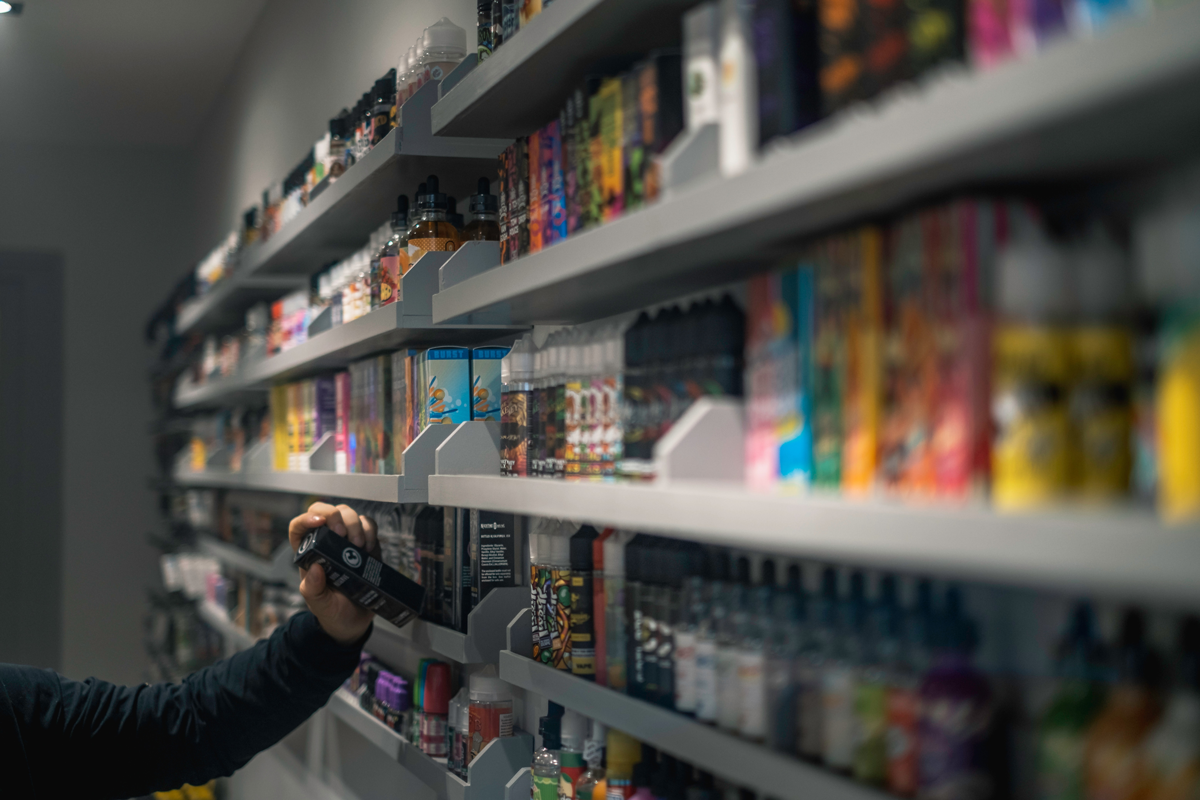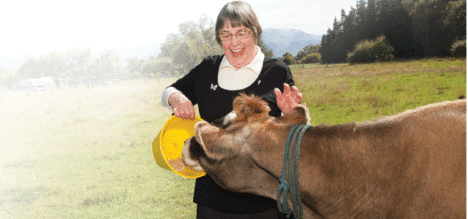Breathe Deep: An Interview on Vaping with Professor Renee Bittoun
October 20, 2023

This article is adapted from Signs Radio episode 195. To listen to the full interview:
Jesse: Professor Bittoun, we first learned about your work through an article that was published in The Conversation February 2023. It’s called “Passive Vaping: Time we see it like second hand smoke and stand up for the right to clean air”. Do you want to tell us a little bit about your background? How did you become interested in this idea of passive vaping?
Professor Bittoun: Well, it goes back to the days when I started in this field in the 1970s. I come from a respiratory physiology background—which is pertinent when you’re thinking of setting up big laboratories, which I did at Prince Alfred Hospital and at St.Vincent’s Hospital. I was specifically at St. Vincent’s to set up testing laboratories to test lung function. And as I was doing that, I thought, gosh, I’m testing all these people who are so sick from smoking. Why are we spending so much money when we can prevent smoking?
I had that thought ticking in my head for some years. And one of my friends and colleagues, who’s now a professor in public health, said to me, “You’ve got such a big mouth, Renee. Nobody’s doing anything about this. Why don’t you do something about it?” And lo and behold, I looked around and sure enough, there wasn’t anybody doing much about smoking except for—I have to say—one particular group called the Seventh-day Adventists who had the “Five-Day Plan”. This is in the late ’60s they’re doing this. I’d never heard really much about it, except that I knew it went over five days. I went to meet somebody (who is still a friend of mine today) called Kevin Price, who then was running this Seventh-day Adventist program. I exchanged ideas and thoughts about this and I thought, perhaps we could do something.
So, I thought, let’s do a smokers clinic—but in a secular space—in a hospital, perhaps more scientific; let’s have a look at the science behind this. And I did. And in 1979, I started the first smokers clinic in Australia and the second one in the world.
Hundreds of people came [to the clinic] and this snowballed into me being asked to head up the “Quit Campaigns” clinics. All those telephone lines that you now know about, we didn’t have any but we had people turning up on our doorstep. There was a big [clinic] at Sydney Hospital for people to come to. It was very important and it went along with the big anti-smoking campaigns we had in the day.
And then, of course, we went for the idea, not just of people quitting, but that people who were passive smokers had a case for saying, “We don’t want this in the home. We don’t want this at work.” And so you probably grew up in an environment where nobody smoked sitting next to you on a bus, or in a train, or at work, or even in the household anymore, in restaurants, and all these areas that we now take for granted as being non-smoking places.
Meanwhile, I’m writing about how you can help people stop smoking and I learned a lot about nicotine addiction. I traveled to some seminal places in, particularly in the UK, not necessarily in the United States. Some places in the United States where they’re studying it, in Canada, we’re doing that, but not necessarily doing much clinical work, which is still today very interesting. I was doing more clinical work. How can I help people stop what I then began to understand as being addicted to nicotine? So, I’ve written a lot of papers, I’ve written some books and textbooks in terms of addiction. So, I’ve gone on to have quite a long history of helping people with their nicotine addiction.
So, fast forward and here we are well into my retirement age. I would have thought I was way past this by now and ready to move on to gardening. But, fast forward, 40 plus years later, and under the radar comes this particularly nasty way of delivering nicotine called vaping, which has been going for some long time. It wasn’t new to me; in the 1990s, I already saw various apparati that people were constructing to vaporise nicotine so that you breathed it in and didn’t smoke it. But it didn’t look like the vapes we know now, the little plastic ones, the disposable battery operated.
Jesse: Were they more comparable to a hookah?
Professor Bittoun: [laughing] No, more like a bong.
Jesse: Oh, okay.
Professor Bittoun: They were sometimes but not always battery operated, sometimes plug-in, a hookah isn’t burned. These were sort of vaporising-types. And some of them went on the principle like inkjet technology, vaporising the ink. You’d vaporise the nicotine and you could breathe it in. And I saw these things already late into the 1990s or so. It’s the technology that’s improved and improved and got so out-of-hand. What’s really nefarious for me and for everybody who knows much about nicotine addiction, is that material can get down into the bottom and to the depths of the lungs very differently from smoking.
So, people just assume vaping’s safer and smoking’s not very safe because it’s got all that particulate matter, right? And because it does, when you’re smoking a cigarette and burning tobacco leaves, really, it does fall on the upper part of the lungs more than it does if it’s vaporised—it gets down deeper. The difference is quite substantial, and this is why I guess I have a particular concern with who’s vaping today. Because it gets down so deep into the alveolar space that—if you know your anatomy—that’s the air sacs of which we’ve got millions and millions. Those air sacs are all covered with blood—arterial blood. If you know your anatomy, there are veins and arteries. The veins are going to the heart and the arteries have come away from the heart. So if you think this through, the lungs are pumping oxygen into the blood and going to the left side of the heart, which then pumps it directly to the brain. This means if you breathe something into the lungs, it actually goes into those arteries and bypasses the right side of the heart. In other words, Putting it crudely, injecting nicotine into your veins.
Now, the people who make these vapes know this full well. These are very fast, very high concentrations of nicotine going into the arterial system if you’re going straight to the brain. And, the brain loves it. I’ll give you another example of a very slow delivery of nicotine; it’s a nicotine patch. Now, I want to declare I do not work with any of the drug companies or for any of them that make these materials like patches, gums, inhalators, whatever. I haven’t for years and years. What’s interesting to know is that there’s no patch addiction. Nobody puts on a patch and goes, “Oh wow, that’s great. That makes me feel better”. Patches take hours and hours to work, not minutes—and not seconds.

And then of course, remember that nicotine is a very short-acting drug. It only lasts in the body about 40 minutes. So, 40 minutes and you’ve got this whack to the brain. And then it wears off. Now, when the brain responds to nicotine, it gets happy—dopamine, serotonin, beta endorphins. Keep in mind, an endorphin is endogenous morphine. That’s what beta endorphin stands for. You release that with nicotine, which is really very dependence producing because then it wears off. So, within the space of 40 minutes, you’re starting to go in withdrawals. And then the immediate decline of it that actually forces you or generates the need to have another one. It’s the speed of delivery that worries me more than anything else.
Jesse: That’s crazy. I know for me and probably the rest of the world, this has seemed like, “oh wow, almost over, overnight vaping is everywhere”. In fact, I was I was just reading an article from The Guardian this morning that says that whereas in 2021, 1 in 50 young women in the UK vaped. In 2022, it was 1 in 15. So, the popularity has just shot up tremendously.
Professor Bittoun: There’s a whole generation who haven’t ever had anything to do with smoking, just like yourself. Australia has had one of the lowest smoking rates in the world. In fact, where we are right now in the northern suburbs of Sydney has one of the lowest in the world. And I get invited around the world to say, how did you do this? What happened in Australia that you, in my lifetime, this is in my career it wasn’t due to me. But . . .
Jesse: You had a significant hand to play in it, though.
Professor Bittoun: Yeah, I guess I did, and interestingly enough the fact that this could be done—bringing the prevalence of smoking down so low that whole generations of kids never saw anybody smoke, let alone want to smoke or even knew what it was, bought a packet of cigarettes—it was unheard of. I think around here where we are in St. Ives, the smoking rate is about five per cent, which is one of the lowest in the world of smoking prevalence.
Jesse: I remember—I was born in ’92 and so, all I knew about smoking was that it was a scary thing and you could only get cigarettes behind the counter. Maybe I’m biased since I grew up as an Adventist and anti-smoking, you could say is almost part of my religion in a way. But I never experienced it and neither did my friends. And that’s why I think it’s so scary now that many of my peers who grew up in that same world I did are now taking up vaping because it’s just seen as normal.
Professor Bittoun: Yeah, it came under the radar really, and particularly as I said, I think Australia is a target for this because here’s a whole community who’s not smoking anymore, but maybe ripe for a whole new generation of consumers. And that’s really why we were targeted because we have such low prevalence of smoking and a whole community of young people who are ripe for the picking and become the next generation of consumers of this product.
The other most scary part for me is, as you say, younger people are doing it. And because we have always known that the younger you were when you started smoking, meaning exposure to nicotine, the harder it was to quit later on in life. So, if you started at 12, it was more difficult than if you started at 18 when you’re 60 trying to stop using. The reason is that our brain develops, unfortunately, a quirky response to nicotine. It shouldn’t really be there. It shouldn’t be in your breath, let alone you reacting to it, let alone you smoking anything or vaping anything. We shouldn’t even be near it.
It’s actually a plant that grows wild all over the world, by the way. In Australia too, we have native nicotine plants and they act as pest repellents. Back in the day, people used to have [problems in the garden with] snails. They’d take out a cigarette and break it open and disperse the tobacco around a plant like a tomato and it would repel the snail because it’s so poisonous.
Jesse: So even animals have the good sense to stay away!
Professor Bittoun: Exactly. We were never built to smoke this stuff.

Jesse: You may have mentioned this already, so forgive me if you have. Let’s talk about dosage and how much nicotine is delivered. Is there a difference between a traditional cigarette and a vape?
Professor Bittoun: It’s a tricky question because we have over the decades learned that what you’re breathing in matters more than what’s in it. I know that sounds a bit strange, but when you “suck hard” on a cigarette and hold your breath, you get more than if you just “puff”. The same applies to vaping, too. So if you’re dragging in and holding your breath, you’re going to get more transit time for the chemical to pass across the alveolar wall into your bloodstream. People who use marijuana know that. It increases the transit time. Smokers have done this for all the time. They wake up in the morning, they drag heavy on a cigarette and then throughout the day, it’s a little lighter. Vapours do the same. So does it matter what’s in it.
For more interviews like this one, subscribe to the magazine in print or digital
Is one vape like 40 packets of cigarettes? That’s become a bit tricky for me to say whether it’s an exact equivalent. We’re trying to look more scientifically at blood levels of nicotine in people rather than how much you’re using. I don’t want to be tricky here but, for example, if a vape has got 3000 puffs in it and you use it up in one day versus using it up in a week, then is that the same?
Jesse: So, it’s not apples to apples.
Professor Bittoun: No, it’s tricky. And there’s a bit of a dilemma there. So, we’re doing some studies. I am with my medical students looking at what’s in your saliva when you vape and what’s that compared to what you just bought? The apparatus you just bought might say 4,000 puffs or 30 milligrams of nicotine. Keep in mind, one milligram of nicotine is a fatal dose. So, how come you don’t die from at least even one milligram? Most of it’s lost in the air. In fact, 80 per cent is in the air.
A nanogram is a millionth of a milligram, but that doesn’t mean that’s not significant to the body. Oh no. The brain goes, “I love this!” That’s significant enough. But most of the stuff that people breathe goes straight out. And that’s why I was so interested in passive vaping. Is it safe to be standing next to somebody vaping when it was never safe to stand next to somebody smoking? So we’re now working on the principle that we had better be very cautious about this. Shall we wait 30 years to say, “okay, yeah, gosh, we didn’t know that passive vaping causes lung cancer or heart disease, because that’s where we’re looking at.
People go, “Wow, yum, that’s pineapple. Isn’t that delicious?” You’re not supposed to be breathing that in, everybody! People forget. This came about because one of my students said, “Oh, look, it’s just pineapple, isn’t that fantastic? It smells so nice. It’s all pretty safe.”
Not really. What makes you think that’s safe? And then you’re breathing in somebody else’s nicotine. 80 per cent of what was in that is dissipated into the room you’re in. If you’re in a car, small space, confined space, that matters, right? The ventilation of that room is a factor, but by no means just assume all of this is safe to you.

Jesse: I have a pregnant wife. I have friends and family members with small children, going through pregnancies all that sort of stuff. And so I’ve become a lot more aware in recent months about the effects that vaping has on young kids, on kids inside the womb, all that sort of thing. This was actually a conversation that was sparked in my family a little while ago about some of the research that’s coming out, and forgive me if I’m misquoting how they’re discovering that potentially a vape can saturate a room and stay on the walls and the surfaces for up to a month, I think was what the thing was saying. So, let’s talk about the passive aspect of it, the potential dangers to children, the potential dangers to babies, the potential dangers to just you and me. What do we need to be aware of?
Professor Bittoun: Primary inhalation is when you’re doing it, secondary is somebody else breathing it in. Tertiary is when it’s on the walls or on the carpets, on the clothing and it’s staying there. People have been looking at a whole gamut of things related to this. One of them is that the nicotine might enter the baby’s bloodstream through the skin. It’s very slow. So, does the baby breathe it in? The answer is probably not, but do they smell it?
And nicotine is odourless. I want to remind you of that. It’s colourless and odourless. It’s not what you smell when you smell somebody smoking. That’s the burning of products in the tobacco leaf. But it’s not nicotine that smells, and it’s not nicotine that stains your fingers. That’s a mistake people make. You don’t smell nicotine but what you might smell is the usage of it.
So, why do some mums wear a gown if they’re a smoker or Nana’s a smoker? Say your grandmother is coming in to cuddle the baby, but she’s a smoker. Put a gown on or change your clothing. The reason why is, the smell of it equates to being held and cuddled and fed. The baby grows up thinking, “The smell of nicotine is the smell I sensed when I was cuddled and held and breastfed.”
I recall speaking to somebody who was probably the most important researcher in nicotine in his time—Mike Russell from the UK. He said to me, “What do you think, Renee? It doesn’t come off the wall and jump onto the person.” However, we now know years later, that that it does stay potent. If nicotine was on the wall of a lab that was testing nicotine in somebody’s urine or blood, it would contaminate the lab. It would contaminate the test. We now know that it’s easy to contaminate. Say somebody was smoking [in a room] 30 years ago, now you have to paint the walls, 30 years later.

And I’ve always said, and this is sometimes quite difficult in some cultures where you can’t say to the person, “you can’t smoke in here” (for example, a patriarch or matriarch). We’ve come across this attitude of, “This is my home. This is my castle. I want to do what I like here.” So, what we’ve advised people like mums who are pregnant and they want to be with them, but they really can’t tolerate this circumstance. What do you do? You take the child and you go outside when granddad or whoever it might be who says, “I’m not moving from this spot.” And sure enough, we’ve seen significant changes because the person learns that it’s unacceptable for my children or grandchildren today. I can’t force my elder to do anything, but I will leave when they doing this. You have the autonomy to do that. You can go out the door with the children until they’ve finished doing whatever they’re doing and you can come back. But I warn you, be consistent. Every time they light up, every time they vape, I’m not here. I’m going out. And we’ve seen this being very successful little strategy to avoid passive nicotine without getting into big fights and arguments.
Jesse: Professor, I want to talk about some of the great stuff that you’re doing with vaping right now but before we get to that, there’s just one more little thing tugging at my brain that I will not be satisfied if we can’t talk about it just a little bit. What I’m getting at is the question of legislation. Now, as you’ve mentioned several times we are in some ways the perfect society to be targeted by these companies because of the great legislation that was enacted in Australia around smoking. My question, and maybe this is a naive question, but why haven’t haven’t governments gotten in ahead of this. Why haven’t we put these companies through more rigour?
Professor Bittoun: Well, The tobacco industry is a really very strong lobbyist around the world. They’ve got a lot of money. And they put this into action both at federal and state levels. So they’re formidable lobbyists. And it really doesn’t take, as I said earlier, a lot of people to counter this lobbying by exposing it for what it is. This is especially true now when we’re looking at this as being a consumer issue and we know that the younger you are, the more likely you’re going to be addicted for life and if you can’t get vapes, you’ll smoke.So, my view is we ban the lot. I often bring up that not that long ago, we once had chewing tobacco in Australia and people go, “Did we?” And I said, “Yeah, we had it. We banned it.” “Did we?” And I always say, “Yeah, we did. And have you missed it?” And nobody even knew we had it, let alone missed it.
So, I’m thinking, we should do what we’ve done in the past. I’m not really a proponent of allowing liberal access to it. What we’ve got now currently is legislation going ahead so that you’ll need a prescription for it. Everybody who vapes with a cigarette or vape containing nicotine, sorry, you’ll need a prescription. 98 percent of all vapes have nicotine in them. I’m for not only having legislation, but also for having litigation. Do what we did then. Don’t just depend on the government to move things, but depend on individuals to move things along. I personally go into vape stores and wave my finger and say to them, “You sell vapes to kids! You’re gone, you’re done!” And I’ve had interesting reactions to that. It’s against the law, selling vapes to kids. We can’t have it. And I, as a grandmother now, I’m not having it. I’m not having all this work destroyed, so that these big tobacco companies can make a buck from my grandkids. And who knows what the health consequences are, let alone the fact that they could be addicted for the rest of their lives. We’re not having it. So I think there’s legislation, but there’s also, public action, I think.
Jesse: So, we know vaping is addictive, but we also know that it’s possible to overcome addiction. You run a really amazing initiative called the Vaping Cessation Clinic. Do you want to tell us a little bit about that?
Professor Bittoun: Thank you. It started to become very evident to me because a lot of people who came and have been coming to Smoker’s Clinic want to quit vaping. And I was wondering also, there is really no vaping cessation clinic. And, back to the future, I thought, It’s time we started this and put some protocols into place, some programs into place.
I don’t know if you’ve noticed, but some people just quit smoking and said, “That’s it, I’m done with it.” But then there are people who are terribly addicted to it. And we know why. It has nothing to do with their personality. “Everybody has an addictive personality.” We’re throwing that into the bin, by the way. It doesn’t exist really. It’s how your brain reacts. You may chemically respond to nicotine and I don’t. That’s it. Are you born to be nicotine addicted? Possibly. It’s a chemistry, like the colour of your eyes. If you’re exposed to nicotine, your brain might latch onto it and we’ve got enough genetic studies to show that some people are more prone to getting what I mentioned earlier, that dopamine, serotonin, beta endorphin release, whereas other people get nothing at all.
Jesse: Wow.
Professor Bittoun: They go, “Look, I tried it and it didn’t do a thing for me. What’s with you?” The other person goes, “Yeah, I tried it and loved it from get-go.” That’s because we know some people are far more prone. It has nothing to do with your upbringing either or your background. It’s just bad luck for you. Now, if you know that, that’s already a relief for some people who are addicted to it, that it’s not their fault. But the younger you are when you started, the more you neuroadapt to nicotine and use it in place of other chemicals that you would use in your brain. When that happens, some people become really very distressed when they try to stop doing it. Now, we have well entrenched, and well documented, studied evidence for getting off smoking. Can we do the same for getting off vaping? It’s all nicotine addiction anyway.
So, we’re pussyfooting around about this a little bit saying, “Oh, vaping cessation, where’s the evidence for that?” That’s a bit of a pussyfoot. I think nicotine is nicotine. In fact, it’s my impression that vaping withdrawals are worse. It’s particularly bad in young kids. They get really serious withdrawals. Remember, between vapes, between this one and the last one I’m doing, I’ve had this terrible anxiety. It’s wearing off. Some kids have this very badly. Others don’t have it at all. So, it makes it difficult. How do we measure this? So we do an assessment. I might measure how much nicotine they’re getting in their saliva. I can measure the metabolite of it. I do that every single attendance. I test them because it gives me an idea of what they’re getting out of what they’re doing. And then how to manage that better.
Professor Bittoun: So we have a protocol for how long you see them. What am I going to do? Am I going to put them on the heavy-duty medications, which we do with smokers, because after all, it’s going to kill them. The bottom line is, you’ve got to remember, one-in-two smokers dies from it. One-in-two, that’s a 50/50 chance you’re going to die prematurely from this. If it were an aeroplane and there was a 50/50 chance it’d crash, you wouldn’t ever want to board that plane!
Jesse: That is insane.
Professor Bittoun: It’s insane. If you know that, and keep in one of the definitions of addictions is that even though you know that, you can’t stop doing it. That’s why something that defines an addiction is loss of autonomy. Kids have low autonomy over this. So then, what are we going to do? We get out the big guns sometimes. Pharmacotherapies, behavioural changes, there’s a lot to do. And we do this for some long time. This is not something that’s going to go away in a couple of days or weeks. We know that relapse is pretty common. And of course, all your friends are doing it. And it’s cheap, which is what we don’t want. It all makes relapse really substantial. So we don’t want to have access. That’s the thing—if we ban this, it’s gone for the vast majority. Is it going to generate an underground illegal market? It’s already got one hell of an illegal market. Is it going to go underground? All drugs go underground, but most people don’t break the law. Most people wouldn’t do some of the horrid things people do for illicit drugs. I think we’ve got good evidence to say that banning is for me personally, and according to the evidence, the best option. As well as, helping people get off it and stay off it.
Jesse: Last note. If somebody wants to get in touch with a clinic, what do they do?
Professor Bittoun: I have a clinic. This is it in Australia and I don’t know of any others really in the world yet. This is probably the one of the first ever at the moment. This is through Ramsey Northside Clinic in Sydney who’ve been very gracious in supporting this hugely. And so, we like to see this work and perhaps spread out around the world, not just in Australia, through the Ramsey clinics.
Jesse: Awesome. Well, hey, Professor Bittoun, thank you so much for sharing on this really quite serious topic. I just want to say thank you for all your work over so many years in smoking and respiratory disease. And now, as you said, in your retirement being on the war path against vaping.
Professor Bittoun: Hopefully my last hurrah because, you know, we don’t want to see this come back in another form again. Thank-you.









